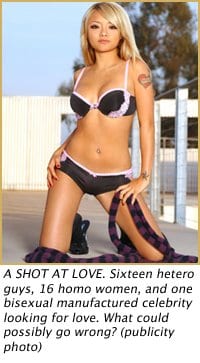In November, Tila Tequila visited my Women’s Studies class. A night course is not the best time to shock students with unexpected displays of nudity, yet there she sat, naked as Christmas with her legs splayed open on the table at the front of the room.
For me, this was to be the beginning of two months of nonstop Tequila bombardment. I had yet to hear of her new reality show — a bisexual version of the bachelorette called A Shot at Love with Tila Tequila — but soon enough I’d be coerced into watching it with friends, lovers and one-night stands.
This wouldn’t be so bad, except that Shot is a TNT-loaded train wreck of a cultural product.
It’s an unstable brick of smoldering dynamite with sticks variously labelled gender, sex, sexuality, monogamy, polyamory, race, class, violence and substance abuse.
It’s impossible talk about all the cultural work being done. I may be a WoStud major, but diffusing that much explosive hardware is a terrifying proposition. Nonetheless, December found me attempting exactly that: beer in hand, I could be heard struggling to unpack Shot’s portrayals of bisexuality, androgyny and sexed bodies. It felt like playing with a book of matches over a powder keg.
Through all this, Tequila remained stationary in my mind’s eye, naked at the front of the class.
Well, not actually. The figure on display belongs to one of my classmates. She’s not Tequila and she’s not naked.
She’s dressed in a bodysuit that matches her flesh tone, nipples, vagina and has Tila tattoos rendered upon it. The course is Monstrous Women, an upper-level Women’s Studies class that combines monster theory, feminist theory and pop culture in the interests of deconstructing monsters as cultural products. This particular classmate has identified Tequila as a cultural monster, and is in the process of outlining her thesis.
The thesis involves a lot of convoluted theory which I forgot in the midst of a holiday whiskey binge. Thankfully, theory’s not the point.
The point is, Tila Tequila’s in my WoStud class and I’m already sick of her face.
The interesting thing is that I’m supposed to be. Sick of her, that is.
Tequila is a postmodern celebrity, a cyber-aged icon famous for being famous.
She’s that internet upstart who redefined fame when she took MySpace self-promotion to a whole new level. The end result was the longest friend list in MySpace history.
She’s since dabbled in music, modelling, fashion design and television, most of which can be attributed to her cyber popularity. Anyone can get a record deal if everyone already knows their name. Tequila’s squeaky, out-of-pitch recordings confirm this fact.
It’s only fitting that Tequila’s newest incarnation comes in the form of a reality show host. Easily the most popular TV genre of the early 21st century, reality TV produces what amounts to millions of mini-Tilas every year: people famous for being famous. The world knows Richard Hatch and Adrienne Curry not because they achieved something magical but because they were on reality TV.
The star of the current pop culture era is manufactured in elimination chambers and straight-to-camera confessional booths.
Shot gives us a few new reality celebrities of its own. Runner-up Dani, for instance, is the lesbian world’s newest heartthrob.
An androgynous firefighter from Florida with the smooth moves of a bar stud, she has fan sites popping up like whack-a-moles all over the web. And let’s not even talk about her grandma, who demonstrates where Dani got her charm when she tells Tequila to “sit that butt down on these knees.” Move over Shane McCutcheon.
Even a little tranny-queer like me isn’t immune to Shot’s manufactured celebrities: if Dani has a cock, I’ve love to suck it.
Dani is more than just masturbation material, however. She confounds the entire logic of the show.
Shot presents its audience with 16 heterosexual men, 16 homosexual women and one bisexual imitation celebrity. After outing herself on national TV, Tequila announces she’s trying to figure out who she wants to be with: a man or a woman. So much for bisexuality.
But fear not: even as Shot attempts to fit everyone back into homo/hetero boxes, our firefighting hero swoops to the rescue.
A boyish queer with a wardrobe and haircut as androgynous as her name, Dani disrupts the show’s plot. At first she seems doomed to a lacklustre performance and elimination, à la Kim Stolz from cycle five of America’s Next Top Model. Butches, bois and dirty little andros never survive the island, right?
Wrong. Dani hangs on like a stubborn oyster.
As the show progresses, straight boys, gay girls and MySpace celebrities alike stumble over their descriptions of her. Campbell’s a… girl? Boy? Neither? No one seems able to decide.
Meanwhile, Dani remains deliciously silent on the topic. She works her lines, stays out of trouble and weasels her genderbent way into the top two.
Thanks to her, the entire premise of choosing “boy” or “girl” collapses.
In the end, Dani gets eliminated in favour of bio-boy Bobby. Tequila reinserts herself into a gender-normative structure of boys, girls, sugar, spice and puppy dog tails.
But I’m all right with that. Dani stalks off into the night, having successfully queered Shot’s binary logic. In this case, the tomboy didn’t have to get the girl to win the game.
Which is not to suggest I’m comfortable with Tila Tequila’s nitroglycerin-packed show. As with all pop culture entities, it both destabilizes and supports hegemonic ideologies in the same instant.
But at least I know it’s working: my WoStud class is staring at Tequila’s bush, I’m in love with Dani and damn near every queer I know keeps saying, “This show is dreadful; I can’t turn it off!”
Everyone’s onboard this death train to nowhere, crowded in a luggage compartment full of ominous crates marked with every explosive issue this side of major controversy.
But at least there’s a firefighter on board.

 Why you can trust Xtra
Why you can trust Xtra


